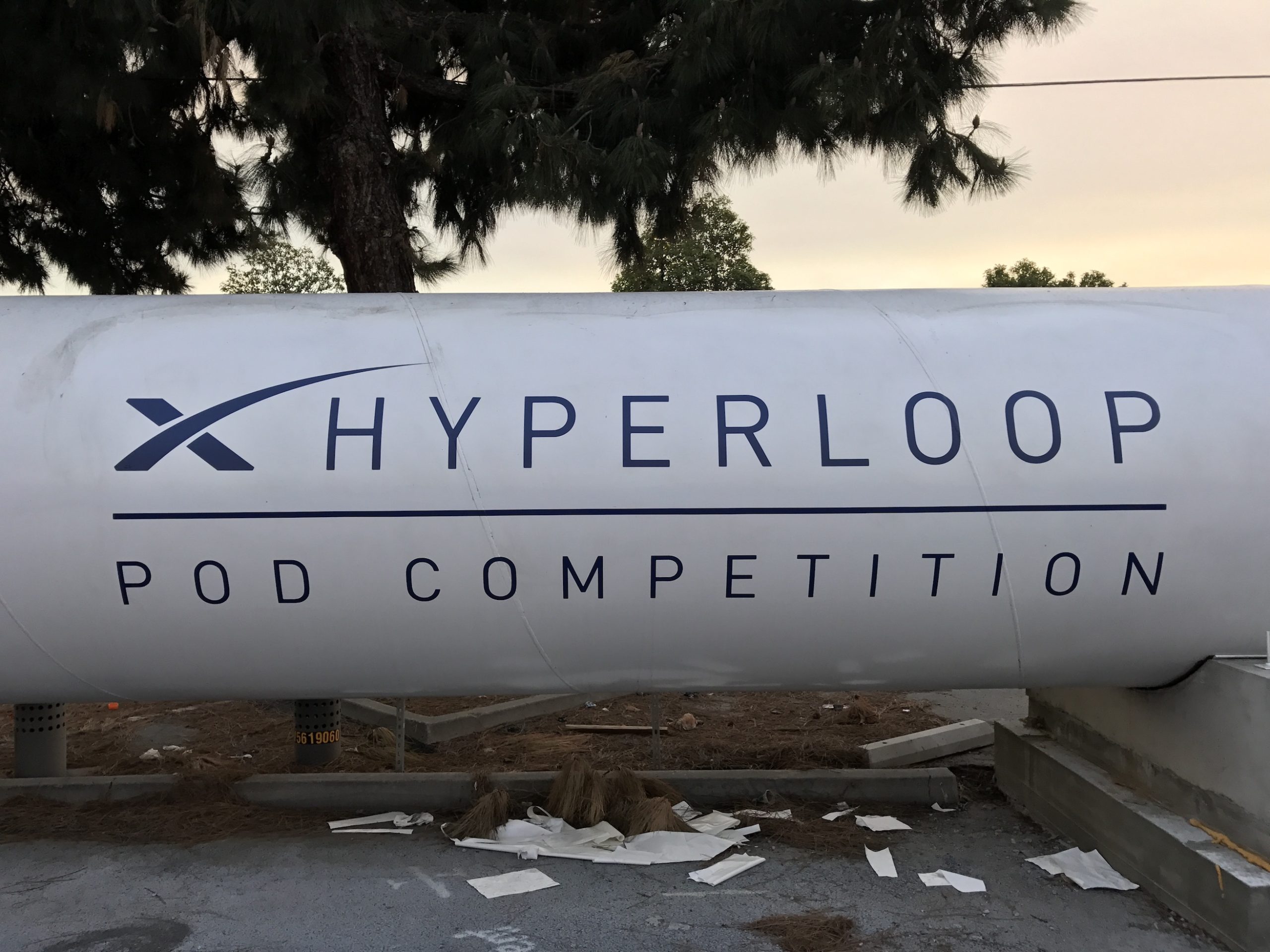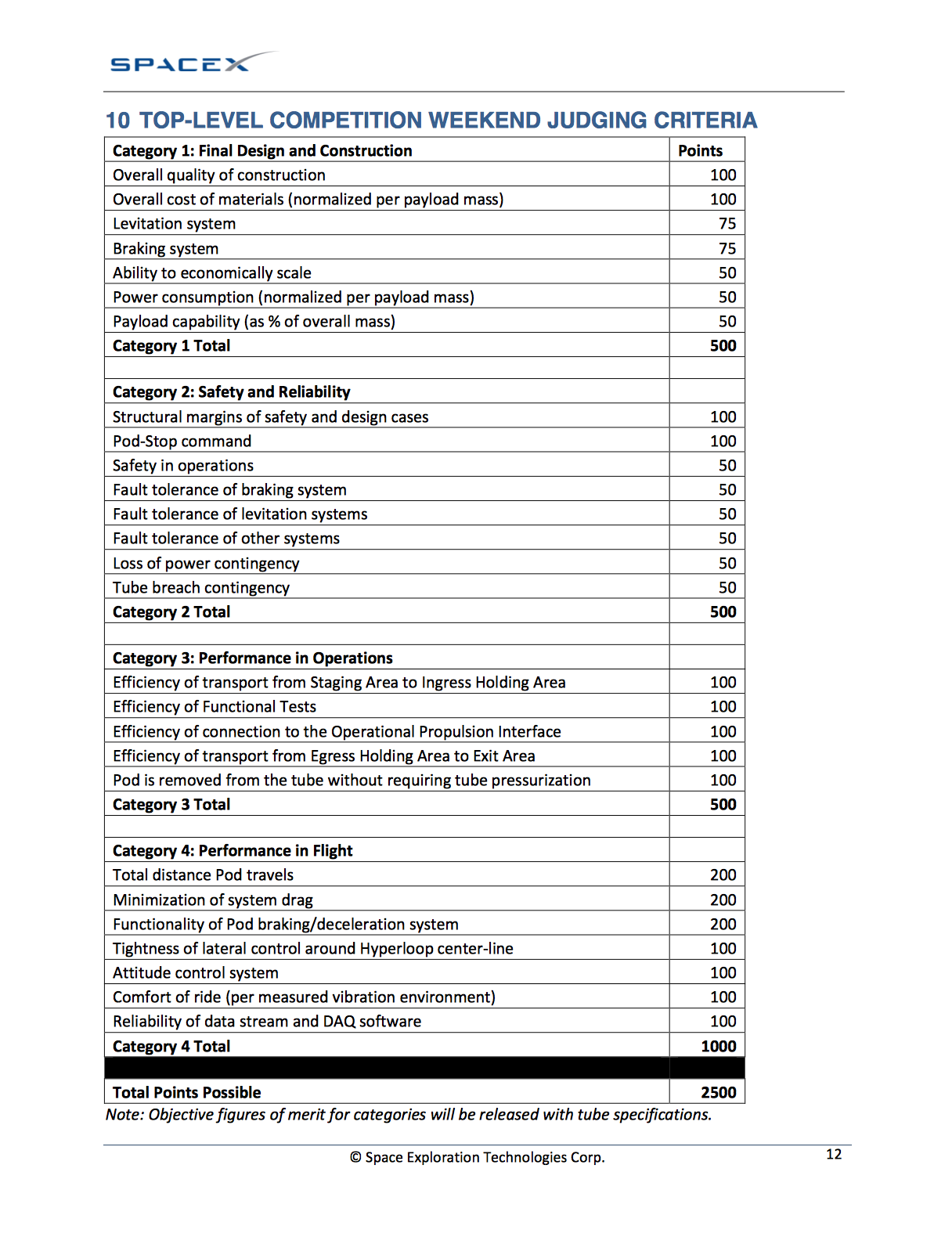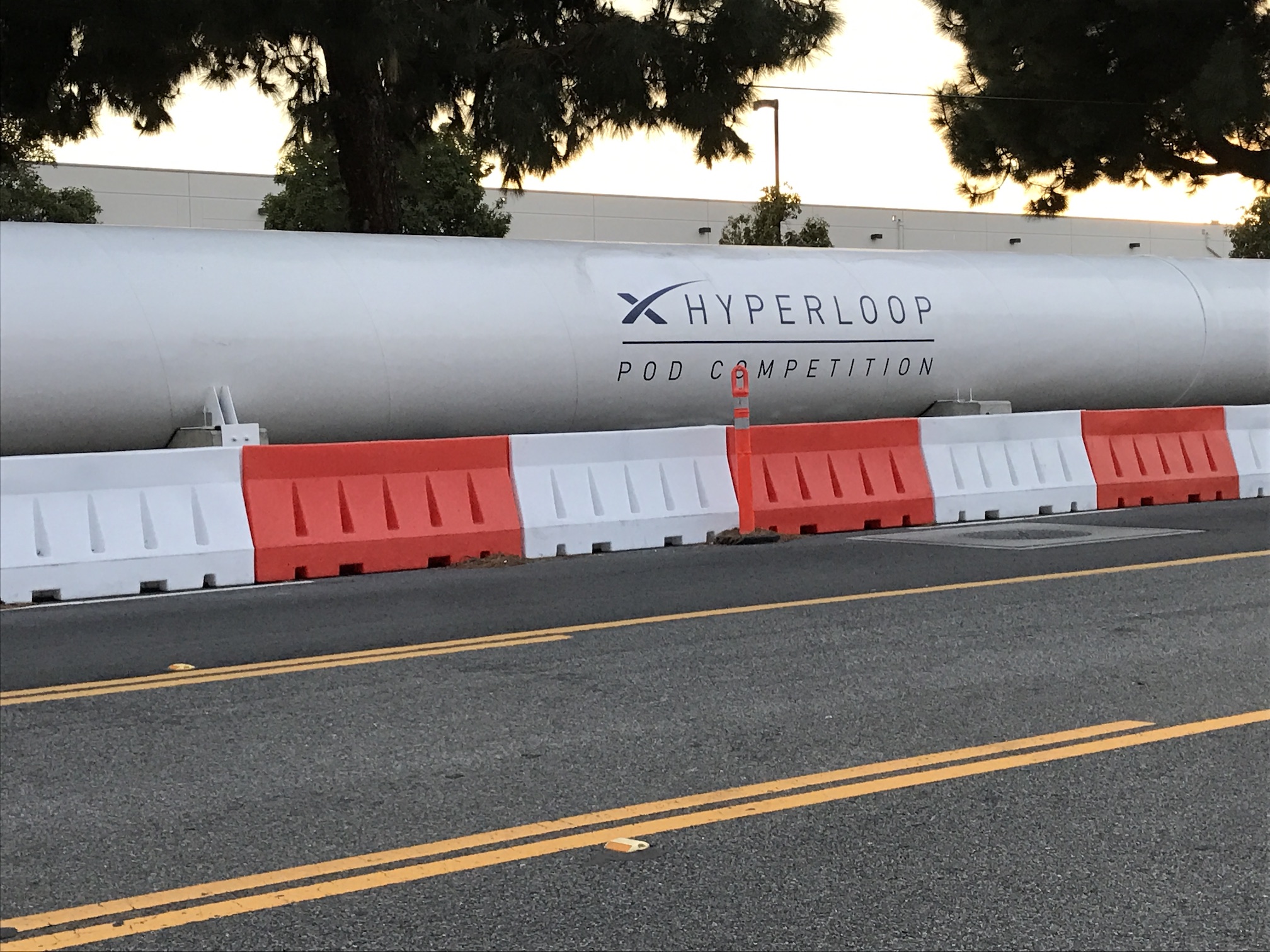News
SpaceX will host Hyperloop Pod Competition next week, Jan 27-29, 2017

Get ready to see Hyperloop concept pods fire through the 1-mile test track located outside of SpaceX and Tesla’s Design Studio in Hawthorne, California, next week between January 27-29. Elon Musk and SpaceX first unveiled the idea for a new high-speed ground transport system called the Hyperloop on August 12, 2013 with the publication of a white paper, the Hyperloop Alpha Preliminary Design Study. SpaceX’s sponsored Hyperloop Pod Competition is an incentive prize competition created to inspire university students and independent engineering teams to design and build a subscale prototype transport vehicle (a “Hyperloop pod”) that will demonstrate technical feasibility of various aspects of the high speed transportation concept. To support this competition, SpaceX has constructed a test track outside of its headquarters which we had the opportunity to see during early construction last year.
There are three judging phases in the Hyperloop Pod competition: a design competition that was held in January 2016 and an on-track competition to be held January 27–29, 2017 (Competition Weekend I), followed by a Summer 2017 (Competition Weekend II). The original specification for the Competition Basic for the Design Weekend and the competition Weekend I, though no longer available at SpaceX, can still be found online.
DESIGN WEEKEND
The Design weekend was held in January 2016 at Texas A&M University. Awards were given in three categories:
SUBSYSTEM
Best Overall Subsystem Award: Auburn University | Auburn University Hyperloop Team.
DESIGN ONLY
Top Design Concept Award: Universitat Politècnica de Valencia | Makers UPV Team
DESIGN AND BUILD CATEGORY OVERALL
Massachusetts Institute of Technology | MIT Hyperloop Team
MIT Hyperloop Team’s design was awarded the “Best Overall Design Award”, among the 23 designs selected to move to the prototype stage. The design proposes a 250 kg (551 lb) pod with a carbon fiber and polycarbonate sheet exterior. It is elevated by a passive magnetic levitation system comprising 20 neodymium magnets that will maintain a 15 mm (0.6 in) distance above the track. The team says with air pressure at 140 Pascals, the pod could accelerate at 2.4 G and have 2 Newton aerodynamic drag when traveling at 110 m/s. The design includes a fail-safe braking system that automatically halts the pod should the actuators or computers fail, and low speed emergency drive wheels that can move the pod 1 m/s. Delft Hyperloop received a “Pod Innovation Award”, while Badgerloop at University of Wisconsin, Madison, Hyperloop at Virginia Tech, and HyperXite at UC Irvine each received a “Pod Technical Excellence Award.” The full list of Awards and news clips from the Design Weekend can be found at the Texas A&M University Engineering web site. Besides the winning teams, several other teams were invited to compete in the upcoming Competition Weekend I from the Design and Build category:
- rLoop (Non-student team)
- University of Waterloo | uWaterloo Hyperloop
- University of Washington | UWashington Hyperloop
- University of Toronto | University of Toronto
- University of Maryland and Rutgers University | RUMD Loop
- University of Florida | GatorLoop
- University of of Colorado, Denver | Team HyperLynx
- University of Cincinnati | Hyperloop UC
- University of California, Santa Barbara | UCSB Hyperloop
- University of California, Berkeley | bLoop
- Texas A&M University | TAMU Aerospace Hyperloop
- Technical University of Munich | WARR Hyperloop
- Purdue University | Purdue Hyperloop Design Team
- Oral Roberts University | Codex
- Lehigh University | Lehigh Hyperloop
- Keio University | Keio Alpha
- Drexel University | Drexel Hyperloop
- Carnegie Mellon University | Carnegie Mellon Hyperloop
In February 3, 2016 eight more teams advanced to Competition Weekend I.
- Cornell University + Harvey Mudd College + University of Michigan + Northeastern University + Memorial University of Newfoundland(Canada) + Princeton University | OpenLoop
- Louisiana State University | Bayou Bengals
- New York University | NYU Hyperloop
- RMIT University | VicHyper
- John’s High School | HyperLift
- University of Illinois at Urbana-Champaign | Illini Hyperloop
- University of Southern California | USC Hyperloop
- University of Wisconsin, Milwaukee | Mercury Three
In the end, 30 of the 115 teams that submitted designs in January 2016 were selected to build hardware to compete in Competition Weekend I. There were more than 1,000 applicants at earlier stages of the competition.
JUDGING CRITERIA
Originally, the second Phase of the competition was supposed to involve competitive runs in the Hyperloop test track to be awarded based on various classes (fully functional pod, susbsystem test pod, etc.) and pod mass. This phase of the competition was renamed“Competition Weekend I,” when SpaceX added a third phase of the competition, Competition Weekend II. The original SpaceX Hyperloop Pod Competition – Rules and Requirements for Weekend I can be seen at the end of this article. We’ve embedded a copy of the original document from SpaceX.
The Judging Criteria are listed in the document, and involve scoring in 4 different categories, for a maximum overall total of 2500 points.
- Category 1: Final Design and Construction (500 points)
- Category 2: Safety and Reliability (500 points)
- Category 3: Performance in Operations (500 points)
- Category 4: Performance in Flight (1000 points)
HYPERLOOP TEST TRACK
AECOM, a company that has designed and built some of the world’s most impressive transportation systems, was selected to design and build the world’s first Hyperloop test track as part of the pod competition hosted by SpaceX
The track is a straight one-mile run on Jack Northrop Avenue, between Crenshaw Blvd. and Prairie Ave. The SpaceX Hyperloop test track — or Hypertube — was designed in 2015 and was constructed in the fall 2016, reaching its full length of one mile by October 2016. The test track’s six-foot diameter steel tube includes a non-magnetic sub-track and said to be capable of achieving 99.8 percent vacuum. The test track itself is also a prototype, where SpaceX anticipates learning from the design, build process and evaluates how to apply automated construction techniques to future Hyperloop tracks.
The Hypertube test track is designed to enable competitors who implement a wide array of designs and build pods that will test a variety of subsystem technologies that are important to new vehicle transport systems. This will include Hyperloop-specific pods—with air-bearing suspension and low-pressure compressor designs—as well as wheeled vehicle and magnetic levitation rail designs that will support a wide array of vehicle technologies to be tested. While the Design Weekend held at Texas A&M University was open to the public, it is unclear if the Competition Weekend I will be as well, or if it will be an invitation only event like many of the SpaceX and Tesla events. Several inquiries for tickets posted to the Twitter account of the Hyperloop Pod Competition went unanswered. The Official SpaceX Hyperloop Pod Competition page does not shed any light on who will be able to attend either.
HYPERLOOP POD COMPETITION II
According to SpaceX, “based on the high-quality submissions and overwhelming enthusiasm surrounding the competition, SpaceX is moving forward with a second installment of the competition: Hyperloop Pod Competition II, which will culminate in a second competition in Summer 2017 at SpaceX’s Hyperloop test track. Hyperloop Competition II will be focused on a single criterion: maximum speed. The second competition is open to new student teams interested in competing on the test track, as well as to existing student teams who have already built and tested Pods to further refine their designs.” The Competition Weekend II event will be held in the Summer 2017 at the same SpaceX Hyperloop test track.
[pdf-embedder url=”http://www.teslarati.com/wp-content/uploads/2017/01/spacex-hyperloop-competition-rules.pdf”]

Elon Musk
Starlink passes 9 million active customers just weeks after hitting 8 million
The milestone highlights the accelerating growth of Starlink, which has now been adding over 20,000 new users per day.

SpaceX’s Starlink satellite internet service has continued its rapid global expansion, surpassing 9 million active customers just weeks after crossing the 8 million mark.
The milestone highlights the accelerating growth of Starlink, which has now been adding over 20,000 new users per day.
9 million customers
In a post on X, SpaceX stated that Starlink now serves over 9 million active users across 155 countries, territories, and markets. The company reached 8 million customers in early November, meaning it added roughly 1 million subscribers in under seven weeks, or about 21,275 new users on average per day.
“Starlink is connecting more than 9M active customers with high-speed internet across 155 countries, territories, and many other markets,” Starlink wrote in a post on its official X account. SpaceX President Gwynne Shotwell also celebrated the milestone on X. “A huge thank you to all of our customers and congrats to the Starlink team for such an incredible product,” she wrote.
That growth rate reflects both rising demand for broadband in underserved regions and Starlink’s expanding satellite constellation, which now includes more than 9,000 low-Earth-orbit satellites designed to deliver high-speed, low-latency internet worldwide.
Starlink’s momentum
Starlink’s momentum has been building up. SpaceX reported 4.6 million Starlink customers in December 2024, followed by 7 million by August 2025, and 8 million customers in November. Independent data also suggests Starlink usage is rising sharply, with Cloudflare reporting that global web traffic from Starlink users more than doubled in 2025, as noted in an Insider report.
Starlink’s momentum is increasingly tied to SpaceX’s broader financial outlook. Elon Musk has said the satellite network is “by far” the company’s largest revenue driver, and reports suggest SpaceX may be positioning itself for an initial public offering as soon as next year, with valuations estimated as high as $1.5 trillion. Musk has also suggested in the past that Starlink could have its own IPO in the future.
News
NVIDIA Director of Robotics: Tesla FSD v14 is the first AI to pass the “Physical Turing Test”
After testing FSD v14, Fan stated that his experience with FSD felt magical at first, but it soon started to feel like a routine.

NVIDIA Director of Robotics Jim Fan has praised Tesla’s Full Self-Driving (Supervised) v14 as the first AI to pass what he described as a “Physical Turing Test.”
After testing FSD v14, Fan stated that his experience with FSD felt magical at first, but it soon started to feel like a routine. And just like smartphones today, removing it now would “actively hurt.”
Jim Fan’s hands-on FSD v14 impressions
Fan, a leading researcher in embodied AI who is currently solving Physical AI at NVIDIA and spearheading the company’s Project GR00T initiative, noted that he actually was late to the Tesla game. He was, however, one of the first to try out FSD v14.
“I was very late to own a Tesla but among the earliest to try out FSD v14. It’s perhaps the first time I experience an AI that passes the Physical Turing Test: after a long day at work, you press a button, lay back, and couldn’t tell if a neural net or a human drove you home,” Fan wrote in a post on X.
Fan added: “Despite knowing exactly how robot learning works, I still find it magical watching the steering wheel turn by itself. First it feels surreal, next it becomes routine. Then, like the smartphone, taking it away actively hurts. This is how humanity gets rewired and glued to god-like technologies.”
The Physical Turing Test
The original Turing Test was conceived by Alan Turing in 1950, and it was aimed at determining if a machine could exhibit behavior that is equivalent to or indistinguishable from a human. By focusing on text-based conversations, the original Turing Test set a high bar for natural language processing and machine learning.
This test has been passed by today’s large language models. However, the capability to converse in a humanlike manner is a completely different challenge from performing real-world problem-solving or physical interactions. Thus, Fan introduced the Physical Turing Test, which challenges AI systems to demonstrate intelligence through physical actions.
Based on Fan’s comments, Tesla has demonstrated these intelligent physical actions with FSD v14. Elon Musk agreed with the NVIDIA executive, stating in a post on X that with FSD v14, “you can sense the sentience maturing.” Musk also praised Tesla AI, calling it the best “real-world AI” today.
News
Tesla AI team burns the Christmas midnight oil by releasing FSD v14.2.2.1
The update was released just a day after FSD v14.2.2 started rolling out to customers.

Tesla is burning the midnight oil this Christmas, with the Tesla AI team quietly rolling out Full Self-Driving (Supervised) v14.2.2.1 just a day after FSD v14.2.2 started rolling out to customers.
Tesla owner shares insights on FSD v14.2.2.1
Longtime Tesla owner and FSD tester @BLKMDL3 shared some insights following several drives with FSD v14.2.2.1 in rainy Los Angeles conditions with standing water and faded lane lines. He reported zero steering hesitation or stutter, confident lane changes, and maneuvers executed with precision that evoked the performance of Tesla’s driverless Robotaxis in Austin.
Parking performance impressed, with most spots nailed perfectly, including tight, sharp turns, in single attempts without shaky steering. One minor offset happened only due to another vehicle that was parked over the line, which FSD accommodated by a few extra inches. In rain that typically erases road markings, FSD visualized lanes and turn lines better than humans, positioning itself flawlessly when entering new streets as well.
“Took it up a dark, wet, and twisty canyon road up and down the hill tonight and it went very well as to be expected. Stayed centered in the lane, kept speed well and gives a confidence inspiring steering feel where it handles these curvy roads better than the majority of human drivers,” the Tesla owner wrote in a post on X.
Tesla’s FSD v14.2.2 update
Just a day before FSD v14.2.2.1’s release, Tesla rolled out FSD v14.2.2, which was focused on smoother real-world performance, better obstacle awareness, and precise end-of-trip routing. According to the update’s release notes, FSD v14.2.2 upgrades the vision encoder neural network with higher resolution features, enhancing detection of emergency vehicles, road obstacles, and human gestures.
New Arrival Options also allowed users to select preferred drop-off styles, such as Parking Lot, Street, Driveway, Parking Garage, or Curbside, with the navigation pin automatically adjusting to the ideal spot. Other refinements include pulling over for emergency vehicles, real-time vision-based detours for blocked roads, improved gate and debris handling, and Speed Profiles for customized driving styles.










